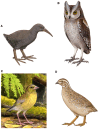A synthesis of terrestrial species extinctions in the Macaronesian Islands and their correspondence with human occupancy
- PMID: 40799346
- PMCID: PMC12343113
- DOI: 10.1093/pnasnexus/pgaf215
A synthesis of terrestrial species extinctions in the Macaronesian Islands and their correspondence with human occupancy
Abstract
We present the first synthesis of all known terrestrial endemic species extinctions in the biogeographical region of Macaronesia, covering all archipelagos (Azores, Madeira, Selvagens, the Canaries, and Cabo Verde) and multiple taxa (arthropods, birds, bryophytes, fungi, land molluscs, lichens, mammals, reptiles, and vascular plants). This list also includes information on the original distribution of extinct species, extinction chronologies, and likely causes of extinction, as reported by the original works' authors. Our survey identified 220 extinction records, with the highest numbers observed among land snails (111 species), arthropods (55), birds (27), and reptiles (15). The proportional impact of extinction was greatest among vertebrates: birds (50% of the original endemics lost), mammals (43%), and reptiles (28%). Very few extinctions were recorded in vascular plants or bryophytes, and none in fungi or lichens. However, these low levels of loss may partly reflect the scarcity of historical and fossil records for these taxa. Exactly half of the recorded endemic species losses (including nearly all vertebrates, as well as the arthropods and vascular plants) have extinction chronologies matching with the human occupation of the islands, providing a minimum estimate of the number of extinction events that may be directly or indirectly attributed to human activities.
Keywords: Macaronesia; anthropogenic change; biodiversity loss; human colonization; island extinctions.
© The Author(s) 2025. Published by Oxford University Press on behalf of National Academy of Sciences.
Figures


Similar articles
-
Integrating plot-based methods for monitoring biodiversity in island habitats under the scope of BIODIVERSA + project BioMonI: Tree monitoring in Terceira, Tenerife and Réunion Islands.Biodivers Data J. 2025 Jun 23;13:e158423. doi: 10.3897/BDJ.13.e158423. eCollection 2025. Biodivers Data J. 2025. PMID: 40708791 Free PMC article.
-
Prescription of Controlled Substances: Benefits and Risks.2025 Jul 6. In: StatPearls [Internet]. Treasure Island (FL): StatPearls Publishing; 2025 Jan–. 2025 Jul 6. In: StatPearls [Internet]. Treasure Island (FL): StatPearls Publishing; 2025 Jan–. PMID: 30726003 Free Books & Documents.
-
Recent extinctions of plant and animal genera are rare, localized, and decelerated.PLoS Biol. 2025 Sep 4;23(9):e3003356. doi: 10.1371/journal.pbio.3003356. eCollection 2025 Sep. PLoS Biol. 2025. PMID: 40906755 Free PMC article.
-
Omega-3 fatty acids for depression in adults.Cochrane Database Syst Rev. 2015 Nov 5;2015(11):CD004692. doi: 10.1002/14651858.CD004692.pub4. Cochrane Database Syst Rev. 2015. Update in: Cochrane Database Syst Rev. 2021 Nov 24;11:CD004692. doi: 10.1002/14651858.CD004692.pub5. PMID: 26537796 Free PMC article. Updated.
-
Systemic pharmacological treatments for chronic plaque psoriasis: a network meta-analysis.Cochrane Database Syst Rev. 2017 Dec 22;12(12):CD011535. doi: 10.1002/14651858.CD011535.pub2. Cochrane Database Syst Rev. 2017. Update in: Cochrane Database Syst Rev. 2020 Jan 9;1:CD011535. doi: 10.1002/14651858.CD011535.pub3. PMID: 29271481 Free PMC article. Updated.
References
-
- Johnson CN, et al. 2017. Biodiversity losses and conservation responses in the Anthropocene. Science. 356:270–275. - PubMed
-
- Matthews T, et al. 2022. Threatened and extinct island endemic birds of the world: distribution, threats and functional diversity. J Biogeogr. 49:1920–1940.
-
- Whittaker RJ, Fernández-Palacios JM, Matthews TJ. Island biogeography: geo-environmental dynamics, ecology, evolution, human impact and conservation. Oxford University Press, Oxford, 2023.
-
- IUCN . Red list categories and criteria: version 3.1. 2nd ed. IUCN, Gland, 2012.
Publication types
LinkOut - more resources
Full Text Sources

